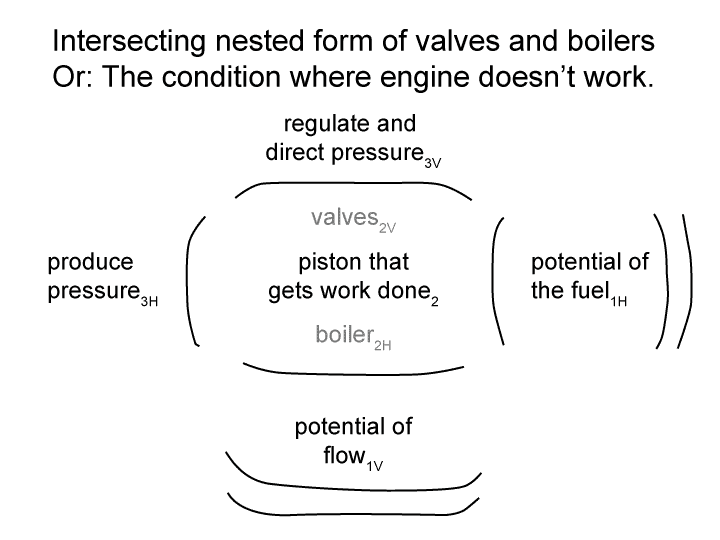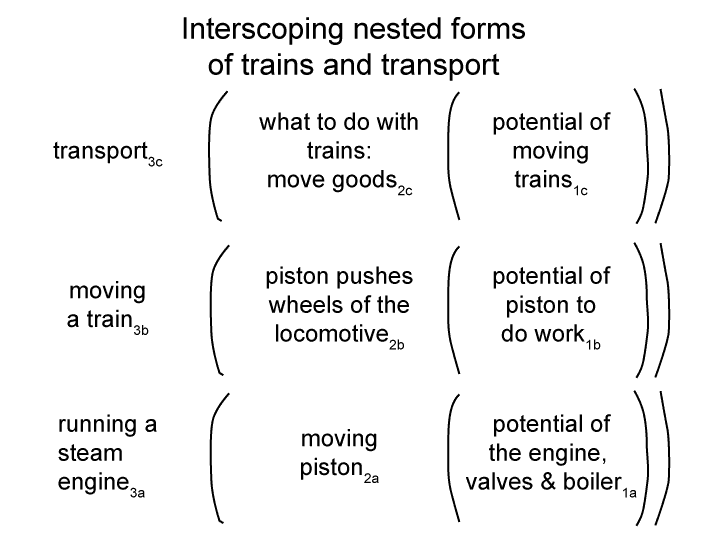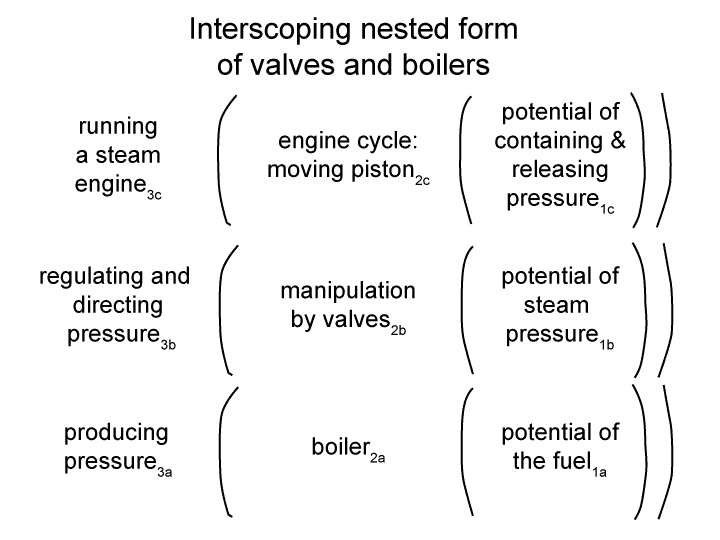Monthly Archives: January 2017
Man and Sin by Piet Schoonenberg (1964) 2.3 H-2
[The single actuality that encompasses valves and boilers emerges from and situates two potentials that seem to have nothing to do with either boilers or valves.
The single actuality underlies the two normal contexts that describe the normal functioning steam engine.
It also belongs to a context that seems to have nothing to do with the mechanics of an engine. The normal context for the single actuality is the running of the engine.
That normal context is informed by the perspective of transportation in figure 2.3G.]
Man and Sin by Piet Schoonenberg (1964) 2.3 H-1
Summary of text [comment] page 80
[Of course, trains are well and good until something goes wrong.
Did the know-it-alls who named ‘the engine bearing unit of a train’ the ‘locomotive’ also know that the word ‘loco’ is slang for ‘crazy’? Word historians take note!
When something goes wrong, the actualities of the boiler and the valves merge into a single problem. The piston does not work!
What could the issue be? The fuel? The flow of water and steam? The pressure? The regulators and valves?]
Man and Sin by Piet Schoonenberg (1964) 2.3 F
Summary of text [comment] page 80
[The piston of the steam engine could accomplish work.
What type of work?
‘Work’ has a technical definition in physics. Here, I mean ‘getting a task accomplished’ in contrast to ‘wasting effort’.
This goes with the perspective level of a steam engine.
The perspective level of the piston may interscope with higher nested forms.
The result is another interscope.]
Man and Sin by Piet Schoonenberg (1964) 2.3 D
Summary of text [comment] page 80
[For those trained in psychoanalysis, please do not blow a gasket.
I am only letting off a little steam.
After all, valves and boilers function like Freud’s ‘unconscious’. But, they know not what they do.
Three interscoping forms describe an engine that powers a locomotive.
On the content level, steam is produced. The ancient Greeks had a toy that spun from the emission of steam. They never thought to turn it into an engine. The mechanical philosophers of the West did, around 2000 years later.
They did so by altering the steam’s situation. The pressure of the steam could force a piston to move. Valves were necessary to do this. One valve opened to let water in. That valve shut and the piston moved from volume produced by steam. Then another valve opened to release the steam.
The valves, then, operated in the normal context of ‘moving a piston’. The moving piston then could be used for work.]
Man and Sin by Piet Schoonenberg (1964) 2.3 C-2
[How about this metaphor?
The person’s psyche is like a steam engine.
Perhaps, the normal contexts of think and law act like regulators. Conscience and dispositions act like fuel.
Sigmund Freud, one of the founders of psychoanalysis, started with a picture of the unconscious as a steam engine powering a locomotive.
Freud wrote between 1890 and 1950 AD (7690-7750 U0′).]
Man and Sin by Piet Schoonenberg (1964) 2.3 C-1
Summary of text [comment] page 80
[This raises the question: Do the models built of interscoping and intersecting nested forms apply to the development of the hardened heart?
Hmmm.
Come to think of it, most other models of the hardened heart are metaphors.
So do the models built of interscoping and intersecting nested forms apply to these metaphors?]
Man and Sin by Piet Schoonenberg (1964) 2.3 B
Summary of text [comment] page 80
The inclination to evil is a sequel to sin. The human (who was not undergone an interior conversion under the influence of grace) will always be self-centered and selfish. These will guide his first actions. These actions will have consequences. The person will look for some way out. His heart will then harden into pride and despair.



